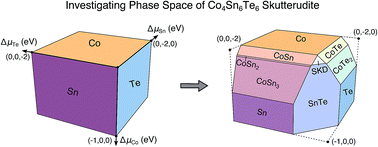Experimental and computational phase boundary mapping of Co4Sn6Te6†
Abstract
Binary Co4Sb12 skutterudite (also known as CoSb3) has been extensively studied; however, its mixed-anion counterparts remain largely unexplored in terms of their phase stability and thermoelectric properties. In the search for complex anionic analogs of the binary skutterudite, we begin by investigating the Co4Sb12–Co4Sn6Te6 pseudo-binary phase diagram. We observe no quaternary skutterudite phases and as such, focus our investigations on the ternary Co4Sn6Te6via experimental phase boundary mapping, transport measurements, and first-principles calculations. Phase boundary mapping using traditional bulk syntheses reveals that the Co4Sn6Te6 exhibits electronic properties ranging from a degenerate p-type behavior to an intrinsic behavior. Under Sn-rich conditions, Hall measurements indicate degenerate p-type carrier concentrations and high hole mobility. The acceptor defect SnTe, and donor defects TeSn and Coi are the predominant defects and rationally correspond to regions of high Sn, Te, and Co, respectively. Consideration of the defect energetics indicates that p-type extrinsic doping is plausible; however, SnTe is likely a killer defect that limits n-type dopability. We find that the hole carrier concentration in Co4Sn6Te6 can be further optimized by extrinsic p-type doping under Sn-rich growth conditions.



 Please wait while we load your content...
Please wait while we load your content...
